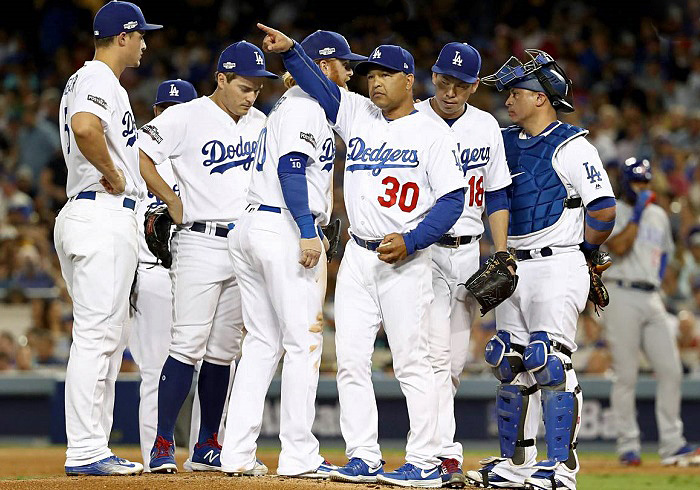The last two days has seen reports by ESPN, Sports Illustrated, The Athletic, CBS Sports, and various media outlets reporting that MLB recently met with the Players Association back on January 14 to propose rule changes for improving pace-of-play in games. Over the last few years MLB Commissioner Rob Manfred has maintained that the amount of idle time in games, not necessarily the length of games, is a significant issue facing baseball as it tries to remain relevant in today’s entertainment industry.
Fans are familiar with the 20-second pitch clock, limiting the number of mound visits, and many have figuratively pulled-their-hair out when managers (notably Dodgers manager Dave Roberts) change pitchers after facing only one hitter, so the proposal to force non-injured pitchers to face a minimum of three hitters is not totally unexpected; the days of the situational relief pitcher may soon go the way of the dinosaurs.

(Photo courtesy of Wall Street Journal)
On Friday, February 1, the Players Association took the opportunity to respond to the MLB proposals, albeit not limiting itself to pace-of-play. No, it saw this as a carpe diem moment and send a message to MLB of its ongoing issues: universal DH; roster sizes; teams manipulating MLB service time; and a hard and fast trade deadline each year before the All Star game. The union has sent a clear message to MLB that it is willing to negotiate rules changes, but it expects some form of good faith, quid-pro-quo for its agreement.
How will MLB respond? Will it view this as an opportunity to start rebuilding its relationship with the union and players before the CBA expires in December 2021 and offer a counter proposal that addresses at least one of the union’s issues? Or, will Rob Manfred exercise his right under Article XVIII of the CBA and unilaterally impose those pace-of-play rules that were proposed one year ago: the pitch clock; and/or further restrictions on mound visits; and/or the runner at second base in extra inning games?
In the future this negotiation may be viewed as one of the defining moments in MLB and the Players Association labor relations, but in which direction?
It will not be long before we have the answer.
* * * * *




 February 7th, 2019 at 8:00 am
February 7th, 2019 at 8:00 am  by 0799291000348
by 0799291000348  Posted in
Posted in 

It’s irrational of me to like an irrational rule just because of the irrational manager who abuses the lack of a such a rule to begin with, but I do. A good pitcher should be able to get any hitter out, just as a good hitter ought to be able to hit any pitcher.
It’s a chicken v. egg thing: how can a lefty hitter learn to hit a lefty pitcher if he’s benched every time a lefty is brought into the game?
I characterize myself as a baseball traditionalist, unless there is a clear need for changing a rule then leave the game alone. Rule changes generally come about to control abuses or concerns for player safety. I well remember when MLB tried to control pitchers from intentionally throwing at hitters by warnings and ejections for retaliation; Vin Scully never liked the rule and said so on-air many times. But Vinny liked the batters helmet rule for player safety. And decades before minor league coach Mike Coolbaugh was tragically killed by a line drive to his head, Vin pleaded on air for a rule requiring coaches to wear helmets.
I applaud the MLB and Players Association for considering the 3 batter minimum for relief pitchers. As a Dodgers fan, Dave Roberts was an easy target for me, but the Rays Kevin Cash and the Brewers Craig Counsel took it to another level by starting a relief pitcher, on occasion only for one hitter.